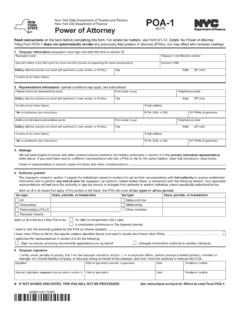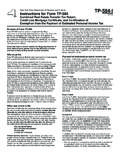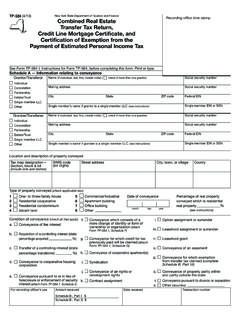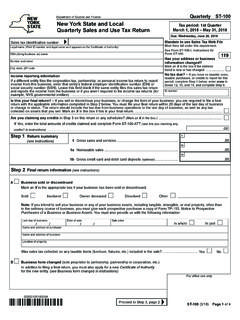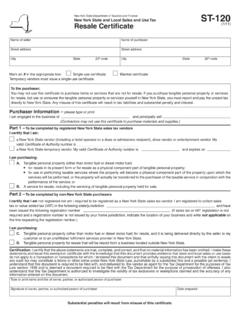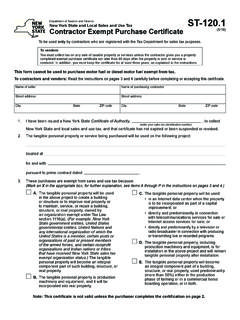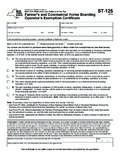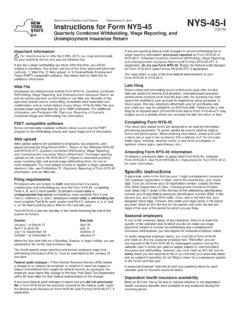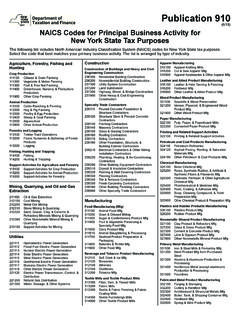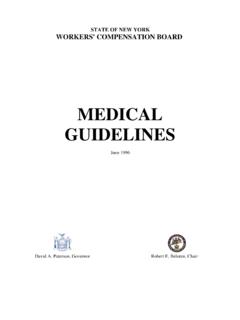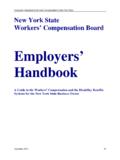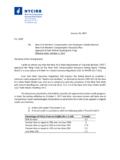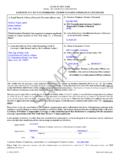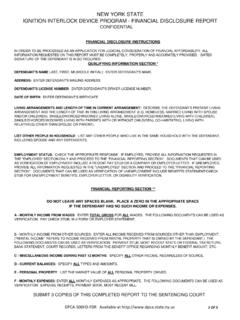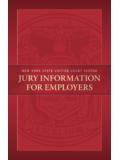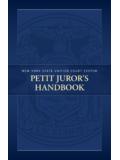Transcription of Pub 20:11/12:New York State Tax Guide for New …
1 Important As a result of New york State corporate tax reform (Part A of Chapter 59 of the Laws of 2014 and Part T of Chapter 59 of the Laws of 2015), the Corporation tax information on page 9 and 10 of this publication is out of date. For the most up-to-date information, see Corporate Tax Reform on the Tax Department website. Publication 20 begins on page 2 below. Publication 20 New york StateTax Guide forNew BusinessesPub 20 (11/12)Note: A Publication is an informational document that addresses a particular topic of interest to taxpayers. Subsequent changes in the law or regulations, judicial decisions, Tax Appeals Tribunal decisions, or changes in department policies could affect the validity of the information contained in a publication. Publications are updated regularly and are accurate on the date issued. The information provided in this document does not cover every situation and is not intended to replace the law or change its 20 (11/12) Table of contents Page I.
2 Introduction ..5 II. Types of organizations and tax responsibilities ..5 Sole proprietorships ..5 Partnerships ..6 Limited liability companies (LLC) and limited liability partnerships (LLP) ..6 Estimated tax on behalf of nonresident individuals and corporate partners ..7 Metropolitan commuter transportation mobility tax (MCTMT) on net earnings from self-employment ..7 New york City unincorporated business tax ..8 Corporations ..8 New york S Corporation taxes ..9 Metropolitan transportation business tax surcharge ..11 Corporation dissolution and surrender of authority ..11 III. Federal employer identification number (EIN)..11 IV. Filing requirements for employers ..12 Unemployment insurance, wage reporting, and withholding tax ..12 New employer registration ..12 Unemployment insurance ..13 Wage Withholding tax ..13 New hire/rehire reporting requirement.
3 13 Employment verification system ..14 Workers compensation and disability benefits ..15 Metropolitan commuter transportation mobility tax (MCTMT) for employers ..15 V. Sales and use taxes ..15 Sales tax registration ..16 Taxable business purchases ..16 Terminating business ..18 VI. Miscellaneous taxes and fees ..19 Cigarettes and tobacco products ..19 Wholesale dealer of cigarettes ..19 Cigarette agent ..20 Wholesale dealer of tobacco products ..21 Distributor of tobacco products ..21 Retail dealer ..22 Vending machine owner and operator ..22 Minimum cigarette prices ..23 Tobacco Escrow Funds Act ..23 Enforcement provisions for the sale, shipment, and possession of c igarettes and tobacco products in New york State ..24 Beverage container deposits ..24 Alcoholic beverages ..25 Registrations, licenses, and permits ..26 Direct wine shipments into New york State by out-of- State 3 Publication 20 (11/12) Table of contents (continued) Page Petroleum products.
4 27 Distributor of motor fuel ..27 Importing/exporting transporter ..28 Terminal Distributor of diesel motor Retailer of non-highway diesel motor fuel only ..28 Distributor of kero-jet fuel only ..28 Aviation fuel business ..29 Residual petroleum product Highway use and fuel use taxes ..29 Highway use tax ..29 Fuel use tax ..30 Taxes for furnishing utility and telecommunication services ..31 Waste tire management fee ..32 New york City taxicab and hail vehicle trip Boxing and wrestling exhibitions tax ..33 VII. Purchasing or acquiring a business or its assets Caution ..33 Sales tax information ..33 Bulk sale transactions (examples) ..36 Real estate transfer tax information ..36 Licenses or registrations ..37 VIII. Business incentives ..37 IX. Additional Recordkeeping for small businesses ..37 Sales and use tax recordkeeping ..38 Tax year.
5 38 Accounting methods for income and corporate franchise taxes ..38 Accounting methods for sales and use tax ..39 Bookkeeping Privacy and confidentiality ..40 Power of attorney ..40 Tax information authorization ..41 Third-party designee ..41 E-ZRep Form TR-2000, Tax Information Access and Transaction Authorization ..41 Online Services ..41 Change in your business information ..42 Permits and licenses ..43 X. New york State assistance ..44 XI. New york City (NYC) assistance ..46 XII. Federal 4 Publication 20 (11/12) I. Introduction Whether you are starting a new business or purchasing an existing one, you will need some basic information about New york State s Tax Law and regulations. This Tax Guide for New Businesses outlines the procedures to follow and the forms to file with the New york State Department of Taxation and Finance (the Tax Department). If you are purchasing an existing business or purchasing assets from an existing business, see Chapter VII, Purchasing or acquiring a business or its assets - C aution, starting on page 33 of this Guide .
6 For information on legal requirements for doing business in New york State and a comprehensive listing of State , local, and federal government agency resources, visit the New york State Web site ( ). For federal tax information, visit the Internal Revenue Service (IRS) Web site ( ). To receive e-mail notifications containing links to newly posted tax information, including publications, TSB-Ms (technical memorandums), Important Notices, Advisory Opinions, and Tax Bulletins issued by the Tax Department, visit our Web site ( ) and sign up for the Subscription Service. II. Types of organizations and tax responsibilities Your responsibilities as a new business owner, whether you start a business or buy an existing business, will vary depending on the type of organization or entity you operate. Regardless of the type of organization you choose, you and your business must comply with federal laws and with the laws of any State in which you operate your business.
7 Before organizing a business, you may wish to consult a professional. Below are brief descriptions of the various business organizations and entities recognized in New york State and the related New york State tax requirements. Sole proprietorships A sole proprietorship is a business owned and operated by one person (a sole proprietor). This is the simplest and most common form of small business organization. Sole proprietors must report their business profits or losses on their federal and New york State personal income tax returns. If you are a full-year New york State resident, use Form IT-201, Resident Income Tax Return. 5 Publication 20 (11/12) If you are a nonresident or part-year resident of New york State who has income from New york sources, use Form IT-203, Nonresident and Part-Year Resident Income Tax Return. If you expect to owe New york State , New york City, or Yonkers income tax when you file your personal income tax return, you may be required to make estimated tax payments during the year.
8 For more information, see the Tax Department Web site, Form IT-2105, Estimated Income Tax Payment Voucher for Individuals, and the instructions for Form IT-2105. Partnerships A partnership exists when two or more persons join together to carry on a trade or business. For federal and New york State income tax purposes, the term partnership includes a syndicate, group, pool, joint venture, or other unincorporated organization that is carrying on a trade or business. The term partnership also includes a limited liability partnership (LLP) or a limited liability company (LLC) that is treated as a partnership for federal income tax purposes. A corporation, trust, or estate is not a partnership (although it may be a partner in a partnership). A partnership reports its income on Form IT-204, Partnership Return, but does not pay State income tax. A partnership, LLC, or LLP t hat is required to file Form IT-204 may be subject to a filing fee and must also file Form IT-204-LL, Partnership, Limited Liability Company, and Limited Liability Partnership Filing Fee Payment Form.
9 A partner that is an individual, estate, or trust must include their share of income from a partnership on their personal income tax return or fiduciary income tax return. A partner that is a corporation will include its share of income from a partnership on its corporation franchise tax return. Limited liability companies (LLC) and limited liability partnerships (LLP) An LLC is an unincorporated organization of one or more members, each having limited liability for the contractual and other liabilities of the business, formed for any lawful business purpose under the Limited Liability Company Law of New york State or any other jurisdiction. An LLP is a partnership that provides professional services and has registered as a limited liability partnership under Article 8-B of the Partnership Law of New york State or any other jurisdiction. An LLC or LLP that has New york source income and is treated as a partnership for federal income tax purposes will be treated as a partnership for New york State tax purposes ( see Partnerships above).
10 6 Publication 20 (11/12) An LLC or LLP that is treated as a corporation, including an S corporation, for federal income tax purposes will be treated as a corporation for New york tax purposes or as a New york S corporation if the New york S election is made (see Corporations on page 8). For more information regarding LLCs and LLPs, refer to Publication 16, New york Tax Status of Limited Liability Companies and Limited Liability Partnerships. For information about the New york City tax treatment of LLCs and LLPs, see Finance Memorandum 99-1 (dated October 21, 1999) available on the New york City Department of Finance Web site ( ). Estimated tax on behalf of nonresident individuals and corporate partners Every partnership (including an LLC or an LLP that is treated as a partnership for federal income tax purposes) that has income derived from New york sources may be required to pay estimated income tax on behalf of its partners or members who are nonresident individuals or corporations (other than New york S corporations).
